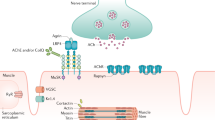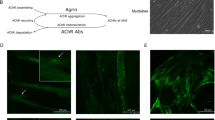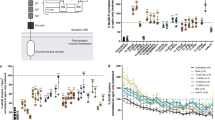Abstract
MYASTHENIA gravis is a muscle disease of man characterised by impaired neuromuscular transmission during repetitive motor nerve activity. Recent studies suggest that the defect in myasthenia gravis is post-synaptic and that myasthenic end-plates have a lower density of functional acetylcholine (ACh) receptors than normal end-plates. Thus end-plates from myasthenic patients show unusually small miniature end-plate potentials1,2, are less sensitive than normal end-plates to iontophoretically applied ACh (refs 2, 3) and bind reduced amounts of α-bungarotoxin4,5—a snake neurotoxin which is considered to bind specifically to nicotinic ACh receptors (see ref. 5). The presence of antibodies against ACh receptors in the sera of myasthenic but not of control patients6–10 suggests that anti-receptor antibodies might act in some way to decrease the number of functional receptors at the motor end-plate. Previous investigations, however, have failed to show conclusively that myasthenic sera contain a factor that reduces muscle ACh sensitivity3,11–13. Here we show that myasthenic sera can reduce the ACh sensitivity of tissue cultured human muscle cells.
This is a preview of subscription content, access via your institution
Access options
Subscribe to this journal
Receive 51 print issues and online access
$199.00 per year
only $3.90 per issue
Buy this article
- Purchase on Springer Link
- Instant access to full article PDF
Prices may be subject to local taxes which are calculated during checkout
Similar content being viewed by others
References
Elmqvist, D., Hofmann, W. W., Kugelberg, J. & Quastel, D. M. J. J. Physiol., Lond. 174, 417–434 (1964).
Albuquerque, E. X., Rash, J. E., Mayer, R. F. & Sattersfield, J. R. Expl. Neurol. 51, 536–563 (1976).
Albuquerque, E. X. et al. Ann. N.Y. Acad. Sci. 274, 475–492 (1976).
Famborough, D. M., Drachman, D. B. & Satyamurti, S. Science 182, 293–295 (1975).
Green, D. P. L., Miledi, R. Perez de la Mora, M. & Vincent, A. Phil. Trans. R. Soc. B 270, 551–559 (1975).
Almon, R. R., Andrew, C. G. & Appel, S. H. Science 186, 55–57 (1974).
Almon, R. R. & Appel, S. H. Biochim. biophys. Acta 393, 66–67 (1975).
Bender, A. N., Ringel, S. P., Engel, W. K., Daniels, M. P. & Vogel, Z. Lancet i, 607–609 (1975).
Lindstrom, J. M., Lennon, V. A., Seybold, M. E. & Whittingham, S. Ann. N.Y. Acad. Sci. 274, 254–274 (1976).
Aharanov, A., Abramsky, O., Tarrab-Hazdai, R. & Fuchs, S. Lancet, ii, 340–342 (1975).
Parkes, J. D. & McKinna, J. A. Lancet i, 388–391 (1966).
Namba, T. & Grob, D. Neurology, Minneap. 19, 173–184 (1969).
Nastuk, W. L., Strauss, A. J. L. & Osserman, K. E. Am. J. Med. 26, 394–409 (1959).
Vogt, M. & Dulbecco, R. Proc. natn. Acad. Sci. U.S.A. 49, 171–180 (1963).
Heinemann, S., Bevan, S., Kullberg, R., Lindstrom, J. & Rice, J. Proc. natn. Acad. Sci. U.S.A. (in the press).
Edelman, G. M. Science 192, 218–226 (1976).
Raff, M. C. Nature 259, 265–266 (1976).
Berg, D. K. & Hall, Z. W. Science 184, 473–475 (1974).
Devreotes, P. N. & Famborough, D. M. J. Cell. Biol. 65, 335–358 (1975).
Chuang, C. C. & Huang, M. C. Nature 253, 643–644 (1975).
Patrick, J., McMillan, J., Wolfson, H. & O'Brien, J. C. J. biol. Chem. (in the press).
Hartzell, H. C. & Famborough, D. M. Devl Biol. 30, 153–165 (1973).
Loor, F., Forni, L. & Pernis, B. Eur. J. Immun. 2, 203–212 (1972).
Lennon, V. A., Lindstrom, J. M. & Seybold, M. E. J. exp. Med. 141, 1365–1375 (1975).
Granato, D. A., Fulpius, B. W. & Moody, J. F. Proc. natn. Acad. Sci. U.S.A. 73, 2872–2876 (1976).
Fertuck, H. C., Woodward, W. & Salpeter, M. M. J. Cell Biol. 66, 209–213 (1975).
Brown, K. T. & Flaming, D. G. Science 185, 693–695 (1974).
Lindstrom, J. M. Clin. Immun. Immunopathol. 7, 36–43 (1976).
Author information
Authors and Affiliations
Rights and permissions
About this article
Cite this article
BEVAN, S., KULLBERG, R. & HEINEMANN, S. Human myasthenic sera reduce acetylcholine sensitivity of human muscle cells in tissue culture. Nature 267, 263–265 (1977). https://doi.org/10.1038/267263a0
Received:
Accepted:
Issue Date:
DOI: https://doi.org/10.1038/267263a0
This article is cited by
-
Myasthenia gravis: An autoimmune response against the acetylcholine receptor
Immunologic Research (1993)
-
Induction of the morphologic changes of both acute and chronic experimental myasthenia by monoclonal antibody directed against acetylcholine receptor
Acta Neuropathologica (1984)
Comments
By submitting a comment you agree to abide by our Terms and Community Guidelines. If you find something abusive or that does not comply with our terms or guidelines please flag it as inappropriate.



